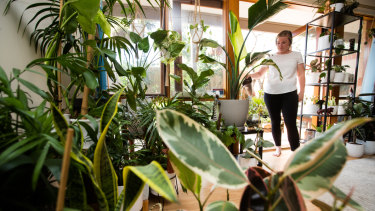
“My husband is always like ‘you need to slow down’.”
IBISWorld data from last year shows the revenue share for indoor varieties at plant growing nurseries jumped from 7.7 per cent to 9.4 per cent over the previous five years. This was a standout performance in the $689 million industry which is under pressure from drought and our changing housing tastes.

Rachel Okell waters one of 70 indoor plants at her home. Credit:Edwina Pickles
At the same time the wider nursery market has shrunk because people are moving into smaller homes and are buying fewer expensive outdoor plants (indoor plants are much cheaper), and because of volatile rainfall patterns.
“The indoor and patio plant segment is expected to grow as a share of revenue over the next five years,” IBISWorld senior industry analyst Matthew Reeves said. “Given the lack of outdoor space [in dwellings], demand will increase for indoor plants.”
Bunnings has seen outdoor plant sales double over the past two years, while Nursery and Garden Industry Australia said there had been a "significant increase" in the volume and value of indoor plants supplied to retailers from 2015 to 2018, but would not put a figure on the increase.
Loading
Bunnings merchandise manager Tracey Lefebure said its most popular indoor plants were Fiddle Leaf Figs, Elephant Ears and String Pearls, with succulents also hot property. She said sales of artificial plants had also grown by 80 per cent year-on-year.
"The increase has happened over the last few years," Ms Lefebure said. "Indoor plants bring the outside inside, and that’s a worldwide trend. It caters for all property sizes."
NGIA revealed, that according to HortInnovation data, Australian growers sold between 43 million and 57 million indoor plants to retailers last year. An NGIA survey also found 53 per cent of independent retail nurseries expected an increase in indoor plant sales this year.
Jan Margarson opened her indoor plant shop Mosey in Melbourne’s hip western suburb of Yarraville in 2012. She spent two years running the business solo and has since hired four staff members.
Ms Margarson grew up in a house filled with plants and believes they’ve always been popular, but says the current boom has been driven by people seeking the physical and mental health benefits they bring, and because of changing living habits.
“There's a generation who've grown up in apartments and haven’t had gardens,” she said.
“People come in and want to remove a certain level of chemicals in their air environment, seeking particular plants to do that. We're also following a European trend. We've always bought plants and put them on bookshelves and coffee table but we are looking at plants now as bigger indoor feature installations."
Anthony is a reporter at The Age.









 Add Category
Add Category